When something that used to be readily available no longer is, it makes what’s still available even more desirable. Especially when it may not be for very much longer.
The ’24 Lexus RC coupe, for instance.
It’s still available with a V6 – and that’s almost like finding a pound of bacon at the store that’s still actually a pound of bacon.
And you can still get it with a CD player. It comes standard with an analog clock. These are two things that aren’t easy to find these days.
Especially the six.
What It Is
The RC is a two-door, four-seater luxury-performance coupe – which all by itself is almost exceptional because there aren’t many such left on the market.
Even fewer that can be bought with a 3.5 liter V6 – for less than $50k.
$48,850 to be precise.
That’s the base price of the rear-drive RC350; opting for all-wheel-drive pushes the price up to just shy of $50k.
You can also buy this Lexus with a turbocharged four for less – $45,920 to be precise. That’s the base price of the rear-drive RC300. And you can also get the 3.5 liter V6 – at a slightly discounted price vs. the RC350 – if you buy the RC300 AWD, which stickers for $48,610.
The price you pay for that is a less powerful version of the V6.
What’s New for 2024
Very little – and that’s very good.
The RC dates back to the 2015 model year – which is a good thing, if you’re not looking for the latest things, such as an unavoidably huge LCD touchscreen sprouting from the dash.
And would like an available V6 engine that doesn’t require a second mortgage to pay for it.
Both the RC300 and the RC350 can be ordered with an F Sport performance package that includes a 19-inch wheel and tire package (with short-sidewall performance tires), selectable drive modes, an adaptive suspension, high-performance brakes, aluminum pedals, perforated leather sport seats, a performance instrument cluster and interior/exterior trim upgrades.
What’s Good
Lexus still makes ’em like others used to.
A steal, compared with the $49,900 price (to start) of a BMW 430i – which comes standard with a four.
Fewer “advanced driver assistance” technologies to nag – and correct – you.
What’s Not So Good
BMW 4’s back seats have significantly more head and legroom, making them more able to actually seat passengers.
F-Sport performance upgrades do not include engine upgrades.
The RC300 comes standard with what’s very available – in almost everything: A 2.0 liter turbocharged four. Not – as Seinfeld likes to say – that there’s anything wrong with that. This engine produces 241 horsepower and is paired with an eight speed automatic – if you choose the rear-drive model. AWD-equipped models get a six speed automatic.
If you do choose the AWD, you’ll also get a 3.5 liter V6 that makes 260 horsepower.
If you want more power to go with that – with or without the AWD – the RC350 comes standard with a 311 horsepower version of the 3.5 liter six, paired with either the eight speed automatic (rear-drive versions) or the six-speed automatic (with AWD).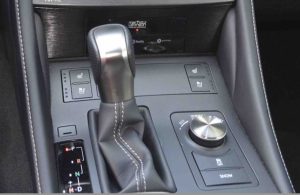
The best part is you can buy a V6 RC for for less than BMW wants for the 430i, which comes standard with . . . a 2.0 liter turbocharged four. One that also makes less power (255). The RC350 also costs about the same as the Audi A5 coupe, which comes standard with a 2.0 liter four that makes 261 horsepower.
But there’s no V6 option on the table here.
Interestingly, the Audi’s four – which is paired with a mild-hybrid system that cycles the engine off as often as possible to reduce fuel consumption – only manages 24 city, 32 highway. The RC300 touts 21 city, 31 highway – an overall difference of about 3 MPG that doesn’t amount to much of a difference.
Also of interest, there’s not much gas mileage difference between the four cylinder-powered RC300 and the 311 horsepower 3.5 liter V6-equipped RC350 – which posts 20 city, 28 highway.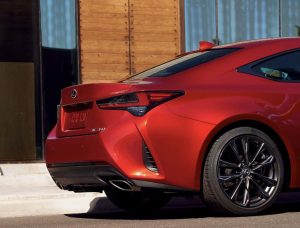
But there is a big performance difference.
The turbo 2.0-powered RC300 can get to 60 in about 7.3 seconds; the 311 horse RC350 gets there in just 5.6 seconds.
Both the 2.0 turbo four and the 3.5 V6 require premium fuel to deliver on their power (and mileage) numbers.
When you first slide behind the wheel of the RC, it’s like traveling back in time ten years. And this is precisely what makes driving the RC more appealing than driving something newer.
There’s that CD slot, for openers.
Digital music has its plusses, of course. You can stream a playlist that runs forever. But CDs are the opposite of virtual – in that they are physical things – and that goes beyond the fact that you can hold them in your hand. You possess them – in the way you posses a book rather than an eBook. It is not something that exists “in the cloud” – wherever that is – over which they have control. CDs – and the analog clock above the CD slot – are reminders of a time when we still possessed (and so actually owned) things. And so had more control over things.
Then there’s the V6 – which is what this ride is really all about.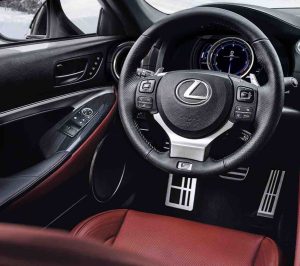
A decade ago, V6 engines were common . . . in Toyotas. In practically everything. You could get a V6 in the Toyota RAV4.
And getting a V6 in a Lexus was a (once) a given.
Today, it’s at least available. And that is what makes the RC something unlike almost everything else (plus the CD player and analog clock). You don’t feel disappointed when you push the start button and hear the sound (the real rather than augmented sound) of something more than a four for the nearly $50k you just spent. This cannot be quantified by such stats as 0-60.
It is something you feel glad that you did.
This V6 is also a legendarily excellent one. Toyota has been installing versions of it in various Toyota – and Lexus – models for 20-plus years. And it is a 20-plus years engine. One – in this case – with a near 7,000 RPM redline that’s smooth as liquid butter all the way there. The sound of it getting there is what this trip is all about, much more so than how quickly it happens.
The tested F-Sport trim has some additional emotional enhancements such as Sport+ mode (the selector is on the console) that transforms the main gauge cluster into an oversized, sport-bike-like tachometer with red backlighting. And the adaptive suspension that’s included as part of the package both smooths and firms up the ride. Though small, it is not tiny – or a tight fit. There is room enough for a larger-than-average driver to comfortably spend several hours driving.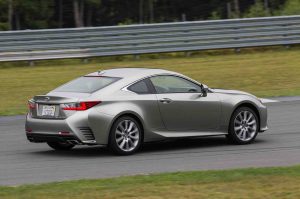
And the driver gets to drive – without being pestered about his driving.
While the RC does come standard with a number of “advanced driver assistance technologies” – including Forward Collision Mitigation and Lane Departure Mitigation – these are much less intrusive than in newer-design cars; you’ll rarely feel (or hear) anything. That includes the engine re-starting itself after shutting itself off every time the RC stops, as for a red light. That’s because the RC does not have “advanced” stop-start “technology.”
Driving the RC reminds one of how enjoyable it once was to drive – without your driving being endlessly interfered with by “advanced driver assistance technology.”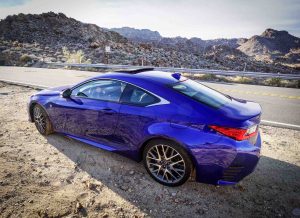
At The Curb
The RC is the smallest of the three main players in this class – the other two being the Audi A5 coupe and the BMW 4 Series (which is basically the two-door version of the 3 Series sedan). All of these are four seaters, which makes them more practical than two door sports cars with no seats in the back.
But the RC’s a bit less practical than its BMW rival, because it is smaller.
Well, shorter.
The Lexus is 185 inches end to end – vs. 187.9 for the BMW. This probably accounts for the Lexus having the least rearseat legroom of the three – 27.3 inches vs. 32.1 for the BMW.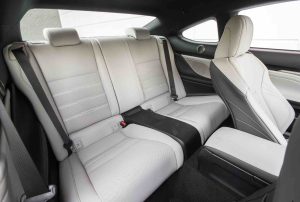
But it’s the sportier roofline of the Lexus – which rakes backward sharply aft of the B pillar – that detracts most from the RC’s backseat passenger-carrying feasibility. Headroom back there is more than 4 inches less than it is up front – 34.8 inches vs. 39 for the driver and front seat passenger. The BMW has 2.3 inches more rearseat headroom (32.5 inches) on account of its more conservative posture.
On the other hand, the price you pay for that practicality is 2.0 liters (and just 255 horsepower) for $49,900 vs. $47,250 for 3.5 liters (and 311 horsepower). Plus, the RC looks like the sports car it’s closer to being – vs. the grand touring two-door/four seater the BMW is closer to being.
The Audi coupe is also slick-looking – though less dramatically so. And it has 32.7 inches of backseat legroom (and 36.1 inches of backseat headroom).
But all you can get is 2.0 liters.
All three of these models have typically tiny trunks, because they have trunks. The RC’s offers 10.4 cubic feet of space; the BMW’s 10.6. The Audi has the “most” – with 10.9 cubic feet of trunk space.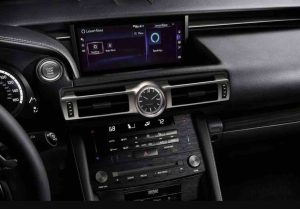
But – again – 2.0 liters . . .
The real point of departure, however, is what you’ll find inside the RC’s cabin vs. what’s no longer to be found in pretty much everything else. And also what you won’t find. There’s the CD slot and the analog clock. And there isn’t a gigantic tablet ticky-tacky sticking out of the dashboard like a giant glowing Pop Tart.
There’s a smaller screen – the kind you used to see in higher-end cars about ten years back. It does not dominate the car’s interior like the huge Pop Tart-like iPads that you regularly encounter in new cars – especially luxury-brand cars.
Looks may be subjective but function isn’t. This Lexus functions better because you do not need to scroll – or tap or swipe – to change the station you’re listening to. You turn the knob.
It’s so 2015.
And it’s so much better.
The Rest
If you want a larger (10.3 inch) touchscreen, it’s available. It’s wider – rather than taller – so it also doesn’t look like a glowing Pop Tart popping upward out of the toaster/dashboard. The CD player is also a DVD player, which means you can play those in the car (rather than stream them from a service, as in the newer-design cars that have that feature).
The available Mark Levinson premium audio system has 17 speakers – which gives a kind of literal meaning to surround sound.
AWD-equipped models get standard heated seats and there’s an available All Weather Package that includes “rapid heating” for the whole cabin, plus a heated steering wheel, windshield and headlight washers.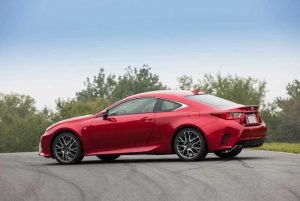
Rear-drive models can be ordered with a Torsen limited slip differential.
The Bottom Line
Who knows how long this will last – or how we’ve come so far, so fast . . . Don Henley’s lyrics about changing times and how fast times change. This may be your final chance to buy a V6-powered luxury sport coupe for less than $50,000.
Or at all.
. . .
If you like what you’ve found here please consider supporting EPautos.
We depend on you to keep the wheels turning!
Our donate button is here.
If you prefer not to use PayPal, our mailing address is:
EPautos
721 Hummingbird Lane SE
Copper Hill, VA 24079
PS: Get an EPautos magnet or sticker or coaster in return for a $20 or more one-time donation or a $10 or more monthly recurring donation. (Please be sure to tell us you want a magnet or sticker or coaster – and also, provide an address, so we know where to mail the thing!)
If you like items like the Keeeeeeev T shirt pictured below, you can find that and more at the EPautos store!



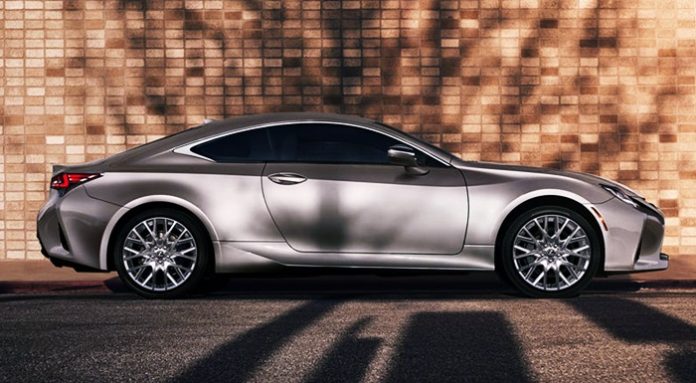

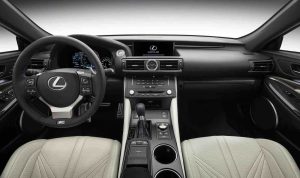
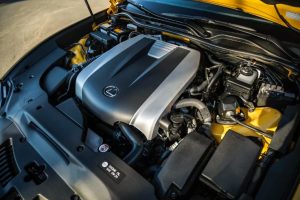








Instead of this Lexus I would prefer this BMW E30 325i…it sounds better…it is cooler…it is a better track car…better build quality….far better driver’s car…more feedback…stick shift…totally analog….it is lighter….no air bags…etc…better investment…
The Perfect BMW? 2.9L Stroker E30 325i….329i….
https://www.youtube.com/watch?v=9oIKKBhj9gM
Hi Aanon,
Well, of course – but you can’t get the BMW 325i (new) anymore!
Great car. Glad it’s till around and hopefully for a lot longer. And they still look great.
My wife was interested in it, but just wanted more power.
She got the caddy ct4-v blackwing for 58, and it’s still avail w a manual too…..we still giggle when we drive it.
the regular v is 47+, and no slouch.
.wav files rock. Id drive that red one even if its automatic only. If the Tesla somehow makes it to LV first this Toyota is high on my list.
This car kind of checks the boxes for what a personal luxury coupe should be. the personal luxury coupe was defined by an eager engine and responsive steering. Acceleration at highway speeds of 70 to 100 mph is snappy. Easy to use controls and switchgear. A driver oriented car. Smooth suspension and responsive steering, coupled with ample front seating and a smooth ride. A cockpit that looks like it belongs in a supersonic jet. If I was in the market, I would consider buying up this last swing at all day highway cruising in a smooth two door car. I miss that category
Recently purchased a ’23 Camry TRD. The 3.5 is fantastic so far, particularly from an aural standpoint with the upgraded exhaust. Plus it’s fairly decent on fuel economy.
When that terrible day arrives, godspeed 2GR-FKS.
I had a 2020 version of this car with a 314hp V6.
Strike one was the driver’s seat which all the tests I read declared very comfortable. If I sat in it for 90 minutes my a** would hurt for three days.
Strike two was severe rattling from the front suspension area over minor bumps in the road.
Strike three was when I first opened the sunroof all the way instead of just tilting it open and found it retracted outside over the top of the car instead of into the roof.
This should have been the best car I ever owned, but its irritations were just to much and I only kept it six months.
Unfortunate and surprising. You’d think Lexus build quality would be higher given its the ‘luxury’ brand. I wonder if they improved on any of those issues in newer model years.
‘It’s still available with a V6 – and that’s almost like finding a pound of bacon at the store.’ — eric
BACON! Woof!
On second thought, though, what really defines personal luxury for me is a straight six (inherently balanced; silk smooth) and a manual transmission.
Like the Lexus RC’s predecessor of thirty years ago, the SC300 coupe. It had a 3-liter inline six with 225 hp, and an available five-speed manual trans.
Toyota still has this tech: a Supra equipped with the 3-liter inline six now sports 382 hp, and offers a six-speed manual.
But in our degenerate, gov-whipped progressive milieu, you can’t have this dream drivetrain in a Lexus at any price. Too bad! I still prefer the SC300, which likewise has a CD slot for playlists that I burn myself, using music I physically own.
As a dying industry, auto makers exhibit regression in available features and maintainability, even as they frantically add chips and Clownscreens and over-the-air updates to their deadly-dull cellphones on wheels. They can kiss my ass.